HOW THE BRITISH POLICE PREPARED FOR THE ATTACK ON SERGEI AND YULIA SKRIPAL, FOUR DAYS IN ADVANCE
by John Helmer, Moscow
@bears_withApril 28, 2020
Armed British police, plus ambulance and medical crews, drone and helicopter pilots, firefighters, and the head doctor of the Salisbury District Hospital’s emergency department were preparing for the attack on Sergei and Yulia Skripal just four days before Russian military assassins arrived from Moscow allegedly carrying a lethal chemical weapon in a perfume bottle.
At least two of the paramedics who arrived at the scene to evacuate them to hospital had been practising in the Swindon operation.Not counting the Skripals and the Russians, the British forces numbered at least two hundred. They were mobilized through the afternoon and night of February 27 until the morning of February 28, in the centre of Swindon, Wiltshire; that is a city 70 kilometres (40 miles) north of Salisbury, also in Wiltshire. The Skripals collapsed at 4:15 in the afternoon of March 4, in the centre of Salisbury.
“There is no intelligence that Swindon is at risk,” a senior police officer had warned, “but I hope members of the public understand we need to be ready and prepared for any eventuality. This is Wiltshire Police getting ourselves – along with our colleagues in the fire and ambulance services – in the best position so we’re ready for anything.”
Until the Skripals are released by the British authorities and permitted to speak freely to their family, their lawyers, and the press, it is not known whether they too were warned in advance to be “ready for anything.”
The British Government narrative of what happened to the Skripals is that they were taken by surprise and poisoned by a Russian-made nerve agent which British government and military officials call Novichok. Two Russians have been identified by name and charged with attempted murder and other crimes, including what then-Prime Minister Theresa May said on March 12, 2018, was “an unlawful use of force by the Russian State against the United Kingdom”.
SWINDON PRACTICE MAKES SALISBURY PERFECT
Left to right: Police cordon around the Swindon city centre, February 28, 2018; source; two alleged Russian assassins walk down a Salisbury street, March 4, 2018; Prime Minister Theresa May accuses Russia of chemical warfare against the UK, House of Commons, March 12, 2018.
Announcing the criminal charges, May said on September 5, 2018: “only Russia had the technical means, operational experience and motive to carry out the attack…We were right to say in March that the Russian State was responsible. And now we have identified the individuals involved, we can go even further…this was not a rogue operation. It was almost certainly also approved outside the GRU at a senior level of the Russian state…this chemical weapons attack on our soil was part of a wider pattern of Russian behaviour that persistently seeks to undermine our security and that of our allies around the world.”
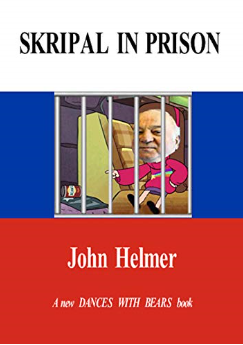
Over the two years which have followed, the proof of what didn’t happen has accumulated, along with evidence of fabrication, concealment, and contradiction in the official versions of the story.
In parallel, the Skripals have been held incommunicado, cut off from their family and from the protection of the British courts. For the full story, read Skripal in Prison.
Disclosure of the Swindon operation on February 27-28 was published locally at the time by the Wiltshire Police in a series of tweets. The police press release to which the tweets refer has disappeared.
A local internet publication, Swindon24, reported the operation’s “scenario saw a firearms incident develop at the Brunel Shopping Centre with police and other blue light services responding to defuse the threat. Ambulance and fire and rescue services responded to deal with casualties from the incident. Around 200 role players took part in the exercise…Details of the exercise were not shared publicly to allow partner agencies to respond spontaneously as they would in a real incident. The area was tightly controlled and the public were not involved… Superintendent Dave Minty said: ‘Routine exercises like this are important as they enable us to test out our ability to deal with large scale incidents. I would like to thank The Brunel Shopping Centre and the local community for their support. The exercise was not based on any threat or intelligence. Although it is unlikely that an incident like this would occur, recent national and international events have once again highlighted the importance of public organisations testing their emergency response procedures to assure the safety of the communities we serve.””
The town newspaper, Swindon Advertiser, reported “Wiltshire Police are remaining tight-lipped as to the nature of the ‘incident’ – which police warned ‘could be noisy’”.
Matching the dates of these media reports with social media at the same time has revealed that senior paramedics from the regional ambulance service Hazardous Area Response Team, as well as air ambulance officers, were identified in the Swindon operation. They then reappeared in Salisbury and have been identified among those involved in the evacuation of the Skripals to Salisbury District Hospital.
The chief doctor at the emergency department of the hospital to which the Skripals were taken is Rachel Oaten. She is a prolific tweeter, describing her work with the Wiltshire Police, the air and ground ambulance crews, and as a qualified pilot of police drones. Oaten was not on duty at Salisbury’s Emergency Department when Sergei and Yulia Skripal were delivered, separately, by ambulance about an hour after their collapse in the town centre. At the time, and for the rest of the evening of March 4, Oaten tweeted that she was assisting a Wiltshire police inspector with “medical advice/support”.
Dr Rachel Oaten (left) was not on duty at the Salisbury Hospital Emergency Department when the Skripals were admitted, and from her tweets during that evening (right), she was not aware of their case at the time at all. Oaten says she was assisting Inspector Gill Hughes; the latter is posted to Warminster, 20 miles west of Salisbury; before joining the Wiltshire police Hughes was in the military police. Source: https://twitter.com/DrOatibix
Oaten is also listed as a director of a small private company providing medical services called Acos Medical Ltd.
One of Oaten’s colleagues, Dr Stephen Davies, is a consultant at the Emergency Department, but like Oaten, he was not on duty when the Skripals were admitted. He was told the next day by colleagues what had been happening in his department before the Skripals were transferred to the Intensive Care Unit of Radnor Ward, one floor above.
Their swift transfer was required, Davies explained this week, “because they required sedation and ventilation, along with other treatments.”
Davies was reported here to have been one of the early witnesses of the Skripals in hospital. Davies has now corrected this record, amplifying what the circumstances were, when he learned them, and from whom. In a lengthy email following his absence from the hospital for the past fortnight, Davies explained: “my letter to The Times has been the cause of much comment and several conspiracy theories. My original letter was longer and clearer but was shortened by the letters editor for publication. Much of it pertains to the difference between testing and treatment, which are of course entirely different.”
‘TREATMENT’, FALSE – THE TIMES; ‘TESTING’, TRUE – STEPHEN DAVIES
TO ENLARGE IMAGES, CLICK TO PRINT
Davies confirms that three patients were tested, diagnosed and treated at the hospital for poisoning. But Davies now acknowledges he was not himself a direct witness, nor did he see them before they were transferred from Emergency to Intensive Care. “I was not on duty the day the Skripals came in but the events regarding their admission were related by my colleagues the next day. I believe they were identified at the time of their attendance by documentation carried on their persons.”
Davies was on duty, he now confirms, at the Emergency Department the following Tuesday, March 6, when Wiltshire police officer, Detective Sergeant Nicholas Bailey, was admitted.
“I did see Mr Bailey myself when he attended with symptoms and he was able to confirm his own identity…Nick Bailey never required ventilation but it was easier for many reasons to have all three patients in one area, so he ended up in ICU as well.”
“The point of my letter was to refute the newspaper statement that many ‘members of the public had attended hospital for treatment’ which was not true. Members of the public had attended for testing and all had been found to have no signs of poisoning. No treatment was ever required or given to anyone other than the original three.”
The three, Davies has reconfirmed, were the Skripals and Bailey.
Bailey’s subsequent testimony to what he witnessed in the Intensive Care Unit indicates that police were posted as if the Skripals were under arrest and to keep them in the ward, not to protect them from possible attack from outside; read more.
According to Davies this week, “there was great concern that ‘members of the public’ (i.e. not the intended victims) were somehow being exposed to a residual or persisting source of poisoning in and around Salisbury and my intention was to allay fears in this group as far as I could, hence my choice of words… In practice, I could have said that, other than those three, no one at all required treatment, public, professional or otherwise.”
What exactly did Oaten, Davies and their colleagues test for? The answer is given by a leading British organophosphate chemist.
“In March 2018, the ‘hot topic’ was Fentanyl. Heroin dealers had been adding Fentanyl and some of its analogues to make their drugs more potent. Carfentanil was especially dangerous, and in the US first responders were dying due to inhalation of powders as they performed first aid to the collapsed users. This led to Naloxone as an injectable, and more personal protective equipment being deployed.
“Ambulance crews, paramedics, emergency department admissions personnel were all very well briefed on the dangers, and there had been many drills to ensure that their own safety was the priority. Two people of different ages, well dressed, are observed by members of the public; then more ‘medically’ qualified people approach (the Army Chief Nurse [Colonel Alison McCourt] and her daughter), then the real paramedics arrive.
“With the victims prone, comatose, breathing irregularly, foaming at the mouth, etc., to the trained and untrained eye this would have all the first appearances of drug toxicity. Especially as the two victims were displaying the same symptoms. At the scene, pulse, pupils, airways, physical injury, e.g. head trauma, bleeding signs, etc., would all be quickly determined. None of the above observations would cause any trained medic to consider that this was not drug poisoning, and of course, although many drugs could initiate these symptoms, Fentanyl was the topic in the news.”
“As we now know, the two victims were admitted via the Emergency Department, and later admitted to the [ICU] ward. It was reported that on the Sunday afternoon around 5pm, two off-duty biochemists were at the hospital, and had just finished their Toxic Dagger exercise and training debriefing. [For details of this Army chemical warfare exercise which was held in the Salisbury area during first three weeks of February 2018, concluding on February 19, read this.]
“It is not known to me when the two biochemists first observed the two victims, but apparently they ‘immediately’ recognised the symptoms as ‘nerve agent’ poisoning, or possibly organophosphate poisoning from insecticide or herbicide ingestion. This observation, possibly in conjunction with the fact that by now Naloxone was having no effect, may then have persuaded the clinicians to attempt another treatment path. In the United Kingdom Accreditation Service, then and now, Salisbury District Hospital [SDH] is not accredited to perform a test for Acetylcholine Esterase.
“SDH’s proximity to Public Health England at Porton Down and DSTL Porton Down would however make it possible for blood samples to be sent to either or both of these facilities in order for the depressed ACE levels to be determined and a new diagnosis made. This new diagnosis was of course vital. Until then the two victims were simply stabilised and ventilated. There was no treatment taking place. By some time on Sunday evening, the ACE levels were known, and possibly as early as that Duodote or similar was administered. Atropine-based antidotes would be vital to keep the victims from drowning by having fluid in the lungs.”
According to this expert source, it is likely the initial blood samples from the two Skripals were sent from the hospital to the rare and imported pathogens laboratory (RIPL) at Porton Down, a civil public health facility, not the Ministry of Defence laboratory (DSTL), which share the same address.
It is also unclear why civilian or military medical personnel involved in the Toxic Dagger exercise were at Salisbury Hospital on March 4, two weeks after the exercise itself had ended on February 19 and its simulated medical clearing stations dismantled. Salisbury Hospital’s Emergency Department had practised how to handle casualties from a chemical poisoning incident, but that was four months earlier, on September 14, 2017.
Left: Salisbury Hospital Emergency Department staff in their chemical warfare exercise, September 14, 2017; Oaten does not mention in her twitter stream that she participated.
Right: Royal Marine and DSTL personnel describe the Toxic Dagger exercise and its medical elements. The Salisbury Hospital appears not to have been involved in the second exercise. https://www.royalnavy.mod.uk/and https://www.youtube.com/
“Regarding other patients arriving at the hospital for testing,” the organophosphate chemist continues, “on the basis that SDH could not test for ACE, any and all ‘contaminated’ people would be required to give a blood sample, and that sample sent away for testing. Some seemed to be symptomatic (headaches, slight nausea, etc.) and there seems no reason for their blood not to have been analysed.
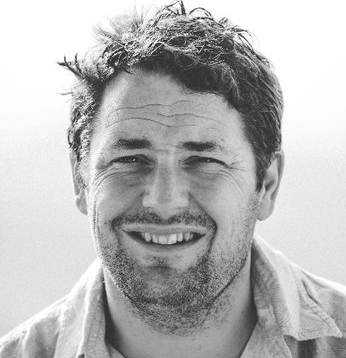 If normal ‘within expected range’ ACE levels were found, then these people would be passed fit. SDH would have seen the more ‘emergency savvy’ patients, who may have had the symptoms. Dr Davies and his team would simply be blood samplers in this exercise. Blood samples sent off with brief patient notes regarding vital signs, symptoms, etc. ACE levels would then come back within the expected range — job done, patients passed fit and healthy.”
If normal ‘within expected range’ ACE levels were found, then these people would be passed fit. SDH would have seen the more ‘emergency savvy’ patients, who may have had the symptoms. Dr Davies and his team would simply be blood samplers in this exercise. Blood samples sent off with brief patient notes regarding vital signs, symptoms, etc. ACE levels would then come back within the expected range — job done, patients passed fit and healthy.”At Salisbury Hospital, the Radnor Ward Intensive Care Unit lists several consultants: Duncan Murray is the lead; Stephen Jukes is one of the consultants, as is Martin Cook (right), a specialist in anaesthesiology. Murray and Jukes have spoken at length with Mark Urban of the BBC and the Secret Intelligence Service. They refuse to answer follow-up questions.
Since the Skripal incident, Cook has given public speeches about what happened.
When asked this week to confirm whether he was on duty at the ICU when the Skripals were first admitted, or later when Bailey joined them, Cook did not reply. He also did not say whether he gave witness testimony about the medical condition of the three, which was recorded at the London court hearing on March 20-21, 2018.
Oaten has also given talks to police and medical organisations on the Skripal case.
Left: https://twitter.com/DrOatibix Right: April 3, 2019 --
Royal College of Emergency Medicine lecture.
Oaten records being invited to participate in a Ministry of Defence training seminar on chemical warfare between July 1 and 6, 2018. Note these dates, as they overlap the hospitalisation at Salisbury of Dawn Sturgess, who was later diagnosed as having been poisoned by Novichok in a perfume bottle. Sturgess was admitted on June 30; she died in the Radnor Ward on July 8; a coroner’s report confirms the particulars. For reports on the case of Sturgess and her companion Charles Rowley, read this.
According to Prime Minister May’s statement to parliament in September 2018, “the same two [Russian] men are now also the prime suspects in the case of Dawn Sturgess and Charlie Rowley too. There is no other line of inquiry beyond this. And the police have today formally linked the attack on the Skripals and the events in Amesbury – such that it now forms one investigation.”
In her social media records at the time, Oaten did not identify the Sturgess case with the Skripal case or link the treatment, as the prime minister claimed later. Only one case of “nerve agent attack”, the Skripal case, was mentioned in this tweet by Oaten on July 2, 2018:
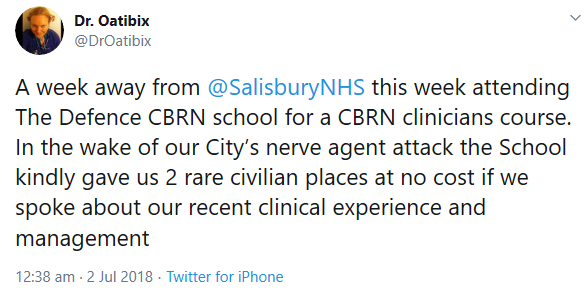
Oaten published several tweets during her week at the training course for
chemical biological radiological and nuclear warfare (CBRN).
This week Oaten was asked if she was on duty at the Emergency Department to treat Sturgess on June 30. Oaten has not answered. According to her Twitter stream, she was on holiday in Wales.



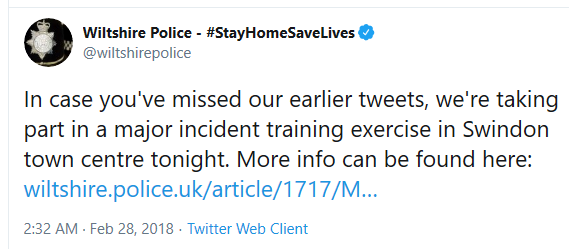
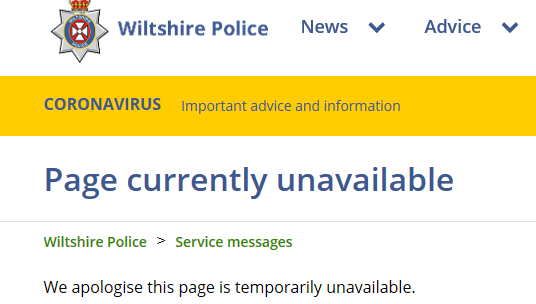
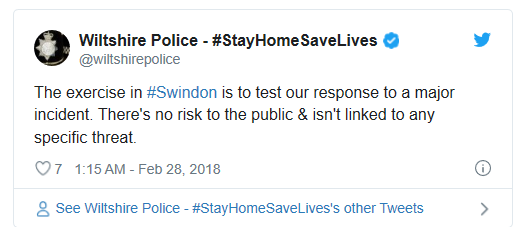
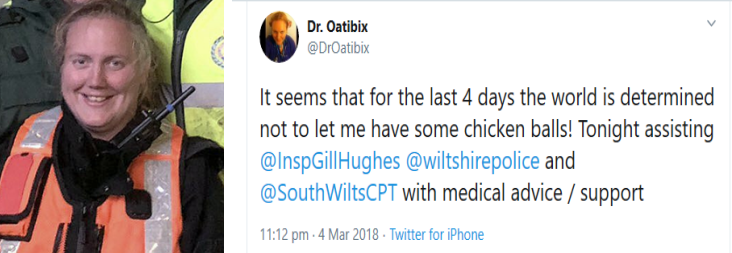
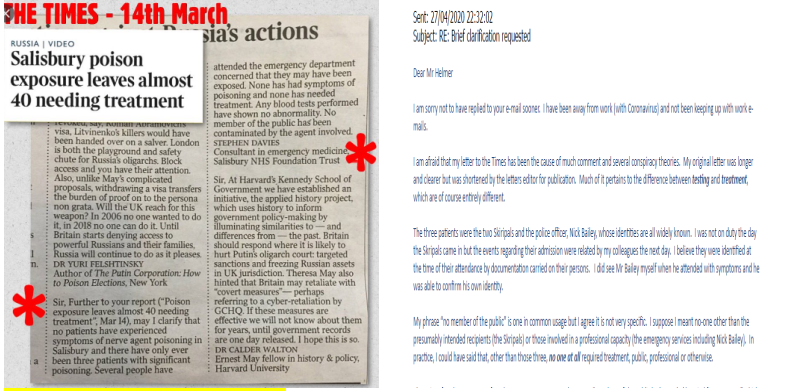

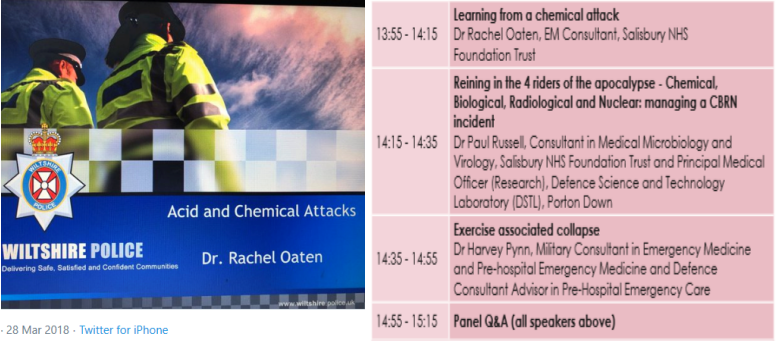
No comments:
Post a Comment